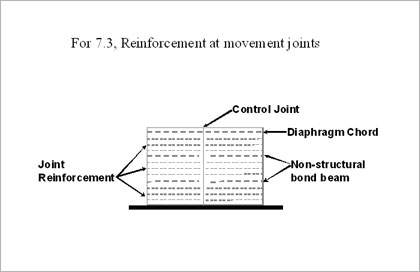Joint Reinforcement
Some type of horizontal reinforcement should be used with all concrete masonry construction to help control shrinkage cracks. Joint reinforcement will not prevent shrinkage cracks from occurring but will help to limit the growth or widening of cracks. One convenient way to include horizontal steel in CMU walls is to embed wire reinforcement in the mortar joints. In areas with high seismic design categories, the need for joint reinforcement is reduced or eliminated. The wall is constructed using bond beams that contain horizontal reinforcement. This type of construction is required to meet minimum seismic requirements but also assists in controlling shrinkage cracks.
Because brick expand rather than shrink, horizontal joint reinforcement is not used with clay masonry except in special situations where it is used to resist structural load. In certain seismic design categories single wire joint reinforcement is required in the construction of brick veneer.
Special seismic veneer ties hook into the wire.
Types & Sizes
Two types of joint reinforcement are produced: truss type (diagonal cross rods) and ladder type (straight cross rods). Ladder type is preferred as the straight cross rods are less likely to obstruct reinforcement and grout placement.
Joint reinforcement can be purchased with a wide range of rod diameters. No. 9-gauge side rods are typical; larger sizes may be specified if more steel area is needed to resist structural loads. Side rods need to be no larger than ½ the mortar joint width, or 3/16” diameter, for typical masonry construction.

What to Do at Expansion and Control Joints
All horizontal joint reinforcement should be cut at expansion and control joints. Do not run joint reinforcement through movement joints or stress concentrations, cracking, and spalling will occur.

Connections Between Wythes In Cavity and Composite Walls
Structural connection between wythes can be incorporated in the horizontal reinforcement. Side rods in ladder type reinforcement span the cavity to bond interior and exterior wythes. Pintle-type triangle ties can be used in conjunction with ladder type reinforcement, with channel slots cast into concrete slabs and with connections to stud construction.
Corrosion protection
The Building Code Requirements and Specification for Masonry Structures specification permits either hot-dipped galvanized or mill-galvanized corrosion protection for joint reinforcement. The 2006 International Building Code requires a hot-dipped galvanized coating for use in exterior walls and interior walls where the relative humidity will be 75% or more. The IBC permits mill-galvanized joint reinforcement for interior applications only.
Construction Concerns
Joint reinforcement is installed in the wall by first laying it on a bare concrete masonry course and then covering it with mortar. Mortar will fill in underneath the joint steel when the next block course is placed.
Joint reinforcement must also be placed to provide 5/8” mortar cover between the face of the side rod and the face of the masonry wall. This cover provides some degree of weather protection.











